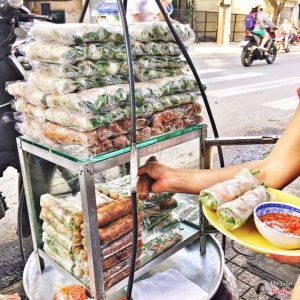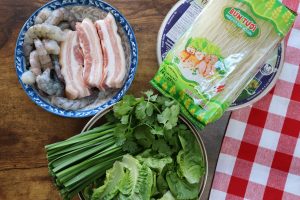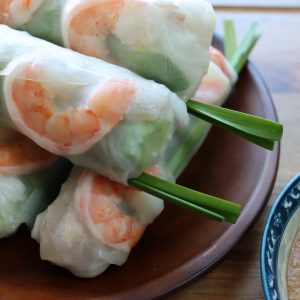Gỏi Cuốn (Fresh Vietnamese Spring Roll (with Shrimp and Pork))

Fresh Spring Roll, or Gỏi Cuốn, is a popular Vietnamese appetizer traditionally served fresh. The essence of this dish is the use of rice paper (called bánh tráng) to wrap a variety of ingredients, such as shrimp, pork, rice vermicelli, lettuce, and fresh herbs. Gỏi Cuốn is distinctly Vietnamese due to the rice paper, and the rolls are served fresh.
Gỏi Cuốn is easy to prepare and highly versatile. The protein fillings can include almost anything: shrimp, pork, chicken, beef, fish, crab, or whatever is locally available. For the herbs and vegetables, you can use a wide range of options, including lettuce, mint, cilantro, chives, cucumber, jicama, starfruit, and more. Some versions of Gỏi Cuốn even omit rice vermicelli. The only essential requirement is the use of rice paper and the freshness of the ingredients.
In most restaurants outside Vietnam, you’ll likely find Gỏi Cuốn in the Appetizers section of the menu. The dish is also a popular choice for social gatherings, serving as a delightful snack before the main courses.
Here are a few notes on my Fresh Spring Roll or Gỏi Cuốn recipe:
- This recipe features shrimp and pork, which is one of the most well-known versions of Vietnamese Gỏi Cuốn. However, feel free to experiment with other ingredients, such as grilled beef, chicken, char siu (Cantonese-style barbecued pork), or eggs. This dish is a great opportunity for your creativity to shine.
- Use thin rice vermicelli for this recipe. Thick noodles can overpower the subtle flavours of the other ingredients and do not absorb the dipping sauce as well.
- The recommended dipping sauce is hoisin peanut sauce, but you can use any sauce according to your preferences. There are no strict requirements for the dipping sauce.
Q&As on Fresh Spring Roll or Gỏi Cuốn
1. What are the typical ingredients for Gỏi Cuốn?

Gỏi Cuốn typically includes the following ingredients:
- Rice paper (bánh tráng): This is the essential ingredient used to wrap the fillings. Rice paper is thin and translucent and becomes pliable when soaked in water.
- Protein: Common choices are shrimp and pork, but you can also use grilled beef, chicken, fish, crab, or other proteins according to your preference.
- Rice vermicelli (bún): Thin rice noodles are often included, providing a light and chewy texture.
- Lettuce: Fresh and crisp lettuce leaves add a refreshing crunch.
- Fresh herbs: Typical herbs used are mint, cilantro, and Thai basil, which add aromatic flavours.
- Vegetables: Additional ingredients may include cucumber, jicama, and sometimes starfruit for extra texture and taste.
- Optional additions: Some variations include shredded carrots, bean sprouts, or even fruits like mango.
Note: The ingredients can be customized based on personal taste and availability. The key is to ensure that all components are fresh and well-prepared for the best flavour and texture.
2. I’ve heard Gỏi Cuốn referred to as ‘summer roll.’ Are they the same thing?
Yes, ‘summer roll’ is another name for Gỏi Cuốn, but it’s not the only term used. In addition to ‘summer roll,’ you might also hear Gỏi Cuốn referred to as ‘salad roll,’ ‘fresh spring roll,’ or ‘rice paper roll.’ All these terms describe the same delicious Vietnamese dish, which features fresh ingredients wrapped in rice paper.

3. What dipping sauce do people use for Gỏi Cuốn?
The most commonly used dipping sauce for Gỏi Cuốn is hoisin peanut sauce. This sauce combines the rich flavours of hoisin sauce with the creamy texture of peanut butter, creating a perfect complement to the fresh rolls. However, there are other popular options as well. Some people prefer a traditional Vietnamese dipping sauce called nước chấm, which is a tangy mix of fish sauce, lime juice, sugar, and garlic. You can also use other sauces based on your personal taste, such as soy sauce or sweet chili sauce. Ultimately, the choice of dipping sauce can vary based on preference and regional variations.
4. Can I make vegetarian Gỏi Cuốn?
Absolutely! Gỏi Cuốn can easily be made vegetarian. Simply omit any animal-based proteins and focus on a variety of fresh vegetables and herbs. Popular vegetarian fillings include tofu, mushrooms, and a range of vegetables like cucumber, carrots, jicama, and bell peppers. You can also add rice vermicelli and a selection of fresh herbs like mint, cilantro, and Thai basil for added flavour. To complement your vegetarian rolls, you can use dipping sauces such as hoisin peanut sauce or a vegetarian-friendly version of nước chấm. The versatility of Gỏi Cuốn makes it a great dish for various dietary preferences.
5. How do you pronounce “Gỏi Cuốn?”
Gỏi Cuốn is pronounced as follows:
- Gỏi: Pronounced like “goy” with a rising tone. The “g” is soft, similar to the English “g” in “go,” and the “oi” sounds like the English word “boy” but with a rising intonation.
- Cuốn: Pronounced like “kwuhn.” The “cu” sounds like “kw” as in “quick,” and “ôn” has a nasalized, slightly open sound, somewhat like the “un” in “sun” but with a nasal quality.

Recipe for Fresh Spring Rolls or Gỏi Cuốn
Enjoy the fresh and vibrant flavours of Vietnamese Gỏi Cuốn with this simple recipe. These delicious spring rolls are made with crisp lettuce, fragrant herbs, tender rice vermicelli, and savoury pork belly and shrimp, all wrapped in delicate rice paper. Perfect for a light appetizer or a refreshing snack, serve with a dipping sauce of your choice for an authentic taste of Vietnam.Please refer to the video instructions at the end of the recipe if you’d like to see how to make Gỏi Cuốn in action.Equipment
- 1 small pot for boiling the pork belly and shrimp
- 1 medium pot for cooking the rice vermicelli
Ingredients
- 1 pound pork belly
- 200 grams shrimp (deveined)
- Rice paper
- Rice vermicelli
- An assortment of vegetables: lettuce, coriander, chives
Instructions
- In a pot, bring water to a rolling boil over medium-high heat. Add the pork belly to the boiling water and cook for about 30-40 minutes, or until it is fully cooked and tender. Once done, remove the pork belly from the pot and set it aside to cool.
- Add the shrimp to the same pot of boiling water and cook for about 2-3 minutes, or until they turn pink and opaque. Be careful not to overcook them, as they can become tough. Remove the shrimp from the pot and set them aside to cool with the pork belly.
- Once both the pork belly and shrimp have cooled slightly, slice the pork belly into thin strips and the shrimp into halves.
- In a larger pot, bring a fresh batch of water to a boil over high heat. Add the rice vermicelli and cook according to the package instructions, usually for about 3-5 minutes, until the noodles are soft and tender.
- Once cooked, drain the vermicelli and rinse it under cold water for about 5 seconds to stop the cooking process and prevent sticking.
- With all the ingredients prepared, you are now ready to assemble the spring rolls.Fill a shallow dish or bowl with warm water. Dip a piece of rice paper into the water for about 5-10 seconds, then lay it flat on a clean surface or cutting board.
- On the rice paper, place a few leaves of lettuce and a small handful of coriander. Add a small amount of rice vermicelli on top of the herbs, followed by a few slices of the cooked pork belly.
- Begin rolling the rice paper from one edge, tucking in the sides as you go to encase the filling. When you’re halfway through rolling, place slices of shrimp and a chive. Continue rolling the spring roll tightly until it is completely sealed.
- Your fresh spring rolls are now ready to serve. Serve them with hoisin peanut sauce or any dipping sauce of your choice.
Video

